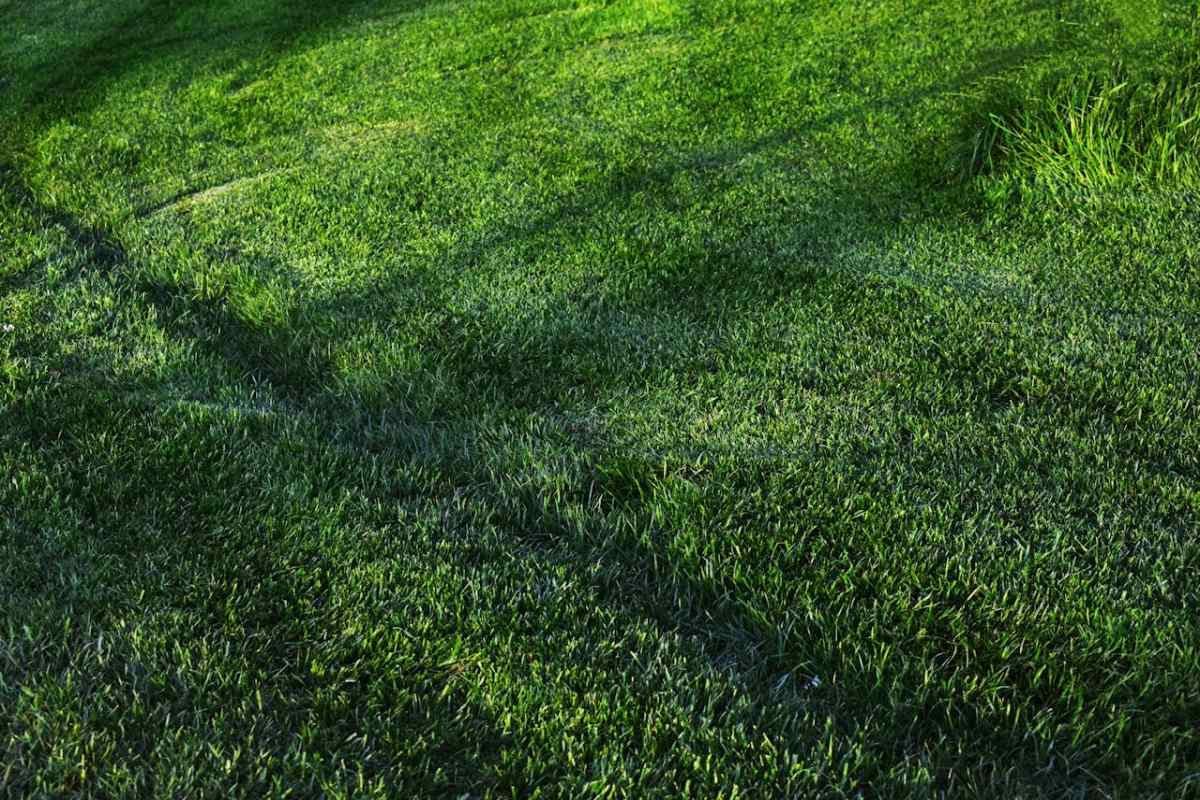
Dream big, go green. How? Get a dark green lawn with this simple formula: test your soil, add nitrogen and iron, water deeply but sparingly, and sow the right grass type.
Does it sound too ‘easy’ to be true? Well, this will depend on your lawn’s overall health, exposure to the sunlight, and how much time and effort you’re willing to put into this dark green quest. Let’s look closer at how you can transform your patchy, pale lawn into a dark green lawn.
Test Your Soil
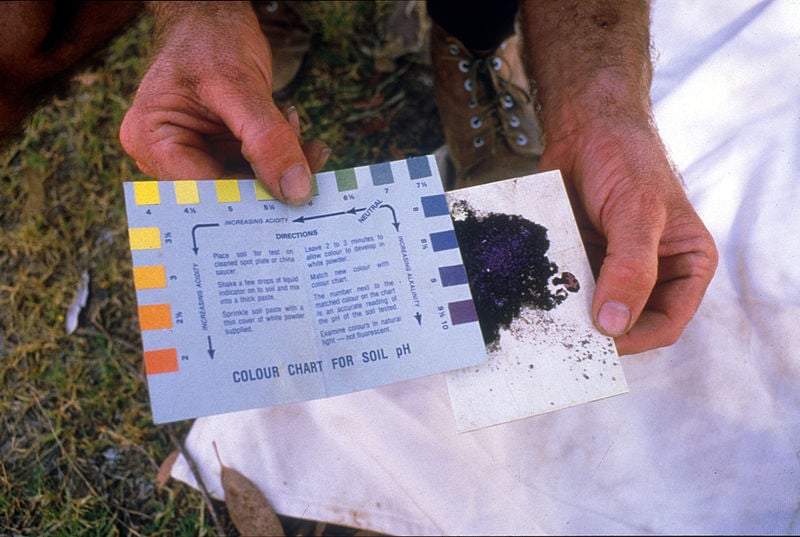
First things first, you have to know the type of soil residing beneath your feet. Your lawn lives through its root system in the soil. Understanding what’s ‘really under’ will let you balance pH where necessary and decide which grass species is best suited for your yard.
You might be thinking, ‘What’s pH got to do with a dark green lawn?’ The answer is simple: balanced acidity ensures that nutrients can be absorbed by your lawn effectively. Too much or too little acidity could make all that expensive fertilizer virtually useless, and you definitely don’t want that.
The ‘healthy’ pH range for most lawns is between 6 and 7 – this middle ground allows essential nutrients to be easily absorbed by the grass. If your soil’s pH falls outside of this range, you may need to add lime (to raise the pH) or sulfur (to lower it.)
But rather than playing a guessing game with your green space, consider bringing in a professional for a proper analysis. Soil testing kits are available at most gardening centers or online. Alternatively, your local agricultural extension office may also provide this service.
Take a quick peek at our simple, friendly guide to understand “Why, When, and How to Test the Soil pH of Your Lawn.”
Choose the Right Grass Variety
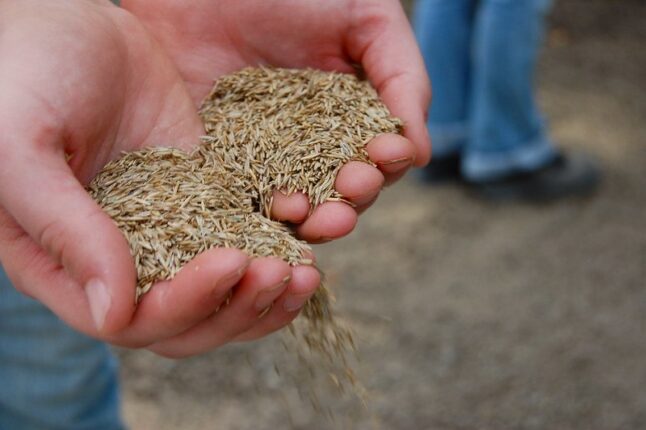
Whether you’re starting anew or overtaking an existing lawn, the type of grass you choose will play a major part in achieving a deep green yard. Some grass species are more likely to develop a dark green color than others. Moreover, cultivated varieties (cultivars) of the same grass species can differ in color, texture, and overall appearance.
Heads-up: If you already have a lighter green grass type, no matter how much care you give it, it won’t turn into an intense forest green. Yes, you can make it maybe a touch darker through the right maintenance, but do recognize its limitations.
Pro tip: To modify (enhance) the overall lawn color without replanting it entirely, you could overseed the existing turf with a darker green variety.
Let’s look at a few popular grass types and their darkest green cultivars. If you live down south, your lawn will have the best results with warm-season grass. If you live up north, opt for cool-season grass to achieve a dark green lawn. If you live in the middle states (known as the transition zone) you can have green success with either grass type:
Kentucky Bluegrass (Cool-Season Grass)
It’s a lush dark blue-green grass with narrow leaves that have boat-like tips. It spreads underground and creates a thick, carpet-like lawn that handles foot traffic well.
Some of the darker green cultivars include: ‘Midnight,’ ‘Blackstone,’ and ‘Total Eclipse.’
Here is our easy-to-follow guide to growing Kentucky Bluegrass.
Turf-Type Tall Fescue (Cool-Season Grass)
Turf-type tall fescue is a great choice for those living in transitional climates. While traditional tall fescue is a light, apple-green color, newer cultivars display a dark green hue. It’s also resistant to drought and heat.
Look for dark green tall fescue cultivars such as: ‘Rhambler 2;’ ‘Titanium 2;’ ‘Traverse;’ ‘and 4th Millennium.’ (Here is our guide, “How to Overseed in the Fall With Fescue”)
Perennial Ryegrass (Cool-Season Grass)
It’s best for cooler regions and is commonly used in sports fields due to its quick germination and excellent traffic tolerance.
‘Pangea;’ ‘Manhattan 7;’ ‘Paragon 2’ and ‘Hawkeye’ are among the dark green variants. (Check out our “Guide to Growing Perennial Ryegrass” for tips on how you can cultivate and maintain this grass type.)
Fine Fescues (Cool-Season Grass)
This family of grasses is perfect for areas with cooler temperatures and transitional zones across the US. They can add a deep green hue to your lawn. Fine fescues are adapted well to the shade and require less maintenance than other types.
Cultivars known for dark color include:‘Evergreen’ (creeping red) ‘ ‘Eureka II,’ (hard fescue) ‘Ambrose’ (chewings Fescue)
Curious about fine fescues for your lawn? Take a peek at our simple guide to growing fine fescues. It’s packed with helpful tips on how to plant and take care of these grasses.
St. Augustine Grass (Warm-Season Grass)
This lush, warm-season turf grass is a perennial favorite in coastal regions due to its salt tolerance. It typically grows into a thick, carpet-like lawn that displays a medium to dark green color, depending on the cultivar. While it can tolerate some shade, St Augustine grass loves the sun.
Maybe not as dark green as the above cool-season grasses, but the varieties ‘Seville’, ‘Classic’, ‘Butterblue,’ ‘Provista’ are renowned for their vibrant green hues.
For tips on how to properly care for and maintain St. Augustine grass, be sure to check out our detailed article, “How to Care for St. Augustine Grass.”
Zoysia Grass (Warm-Season Grass)
Zoysia grass is another warm-season turf that you might consider to achieve a dark green lawn. This species can handle high traffic and also provides excellent drought resistance. Its leaves are naturally darker, but the specific shade can vary from light to dark green depending on the variety. It can also tolerate some shade.
Some of the best known darker green cultivars include: ‘Zeon Zoysia,’ ‘Emerald Zoysia,’ ‘Geo Zoysia, ‘ and’ Zorro Zoysia.’ (Here is our guide: “Growing Zoysiagrass: Everything You Need to Know”).
Fertilize Wisely
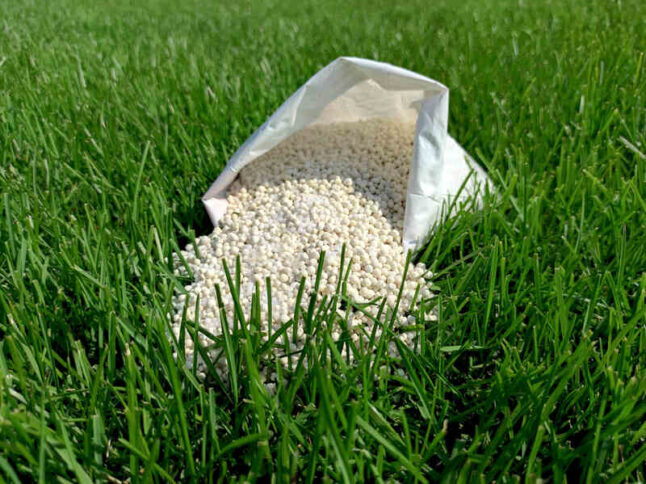
Nitrogen is the key element in achieving a dark green lawn. It aids in chlorophyll production (the pigment responsible for providing grass with its deep green hue) and also promotes vigorous growth. In most turf fertilizers, nitrogen is the first of three numbers on the label. These numbers represent the percentage of:
- Nitrogen (N),
- Phosphorus (P),
- Potassium (K).
No matter the type of grass you have, it needs just the right balance of nutrients to achieve a deeper green color. This does not mean drowning your lawn in fertilizer or applying it at the wrong times. Over-application can lead to burning or chemical buildup, defeating your quest for a dark green yard.
Different turf varieties have different nutrient needs; warm-season grasses typically require more nitrogen than cool-season grasses to maintain their color in the growing season. Thus, it pays to perform a soil test (as mentioned above) or consult with a local lawn care professional before proceeding with any fertilizer application.
*Note: Apply slow-release fertilizer during the peak growth period of your particular grass type. For cool-season grasses, fertilize mainly in the fall and lightly in spring. For warm-season varieties, late spring or early summer is the best time.
Check out our quick guide to lawn fertilization. It’s got all the tips you’ll need for when to fertilize and how much – helping your grass get that rich, green color.
Apply Iron Supplements
If you’ve been pushing the N-P-K (nitrogen, phosphorus, and potassium fertilizer) and your lawn is still not reaching the desired shade of green, it could be time for an iron boost.
Iron plays a significant role in photosynthesis and chlorophyll (which gives green plants their color) synthesis. If your soil lacks this essential nutrient, your grass may appear yellowish instead of a healthy, dark green. These are just some of the many reasons to apply iron fertilizers.
Apply iron sulfate or chelated iron directly to your lawn. Alternatively, several fertilizers come with mixed-in iron for those having difficulty maintaining their green lawn. Remember: always read the product label and follow instructions closely when applying such supplements.
Here are a few general guidelines for applying iron to your lawn:
- The best time to apply iron is in the spring when temperatures are in the 60s to 70s degrees Fahrenheit. Avoid applying iron during the heat of the day. In high temperatures, foliar applications of some products can burn the grass.
- Iron supplements can leave rusty stains on concrete, so be sure to sweep or blow any overspray off your sidewalks and driveway immediately after application.
- Iron is most effective for treating yellowing in lawns when the underlying cause is an iron deficiency in the soil. If yellowing is due to other issues like lack of water or nitrogen, iron may not help.
- Iron’s effects are relatively short-lived, lasting about 2 to 4 weeks in most cases before reapplication is needed.
For more on iron deficiencies, read our article “How to Treat Iron Chlorosis in Lawns.” It guides you through identification, causes, prevention, and treatments.
Water Deeply and Infrequently
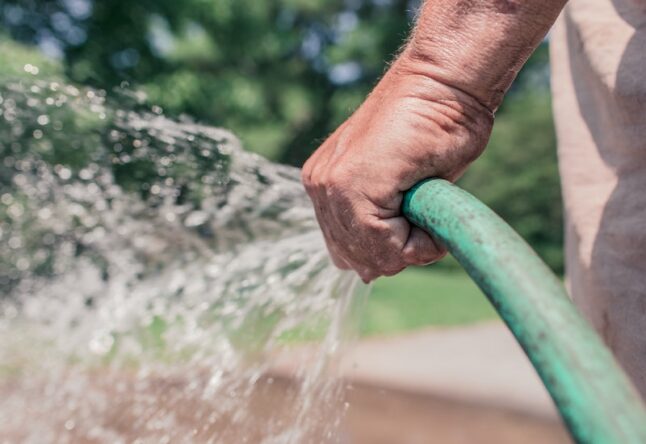
While watering is one of the most obvious aspects of lawn care, it’s also one where many homeowners go wrong. During the warmer months, your first instinct might be to pull out the hose and douse your lawn daily.
Yet this can actually discourage healthy root growth, making your grass less resilient and potentially turning it a shade lighter. To achieve that wonderfully dark green hue, you need to water your lawn deeply and infrequently.
Here’s what that really means:
- Shower your lawn with enough water to soak the top 4 to 6 inches of soil – usually around 1 to 2 inches of water – which can be achieved in a single session or stretched across two sessions in a week.
- Keep an eye on the weather when planning watering schedules. If you’re expecting significant rainfall, you can skip an irrigation session or adjust as needed. Remember, overwatering can lead to shallow root systems and increase grass susceptibility to diseases.
- For a uniformly green lawn, water it evenly. Patchy watering can result in an inconsistently colored yard – some areas may be lush and dark green, while others can appear dull and light.
- Watering early in the morning, preferably before 10 am, is advisable. Mornings are usually cool and less windy, which reduces the evaporation of water, allowing it to penetrate deep into the soil.
For more insights on the optimal frequency and quantity for watering your lawn, don’t forget to check out our article, “How Often Should I Water My Lawn?”
Mow High and Often

You might already be a seasoned pro with your push or ride-on lawn mower whipping around your yard every weekend. But are you doing it in a way that contributes to your lawn’s deep green appeal? Sometimes, the smallest slip-ups can create quite a difference.
Mowing more often yet cutting less grass allows your lawn to have a thicker density. And when it comes to appearing dark green, a high-density turf can create an illusion of depth and richness.
If you mow too low – removing more than one-third of the leaf blade’s height at once – your turf may turn a little pale as it struggles to recover and protect itself from extreme temperatures.
Pay special attention to these important mowing tips to help your lawn reach its fullest green potential:
- Adjust Your Mower Deck: Did you realize that mowing your grass too short can change its color? If the grass is taller, it has more chlorophyll to soak up sunlight. This helps promote healthier growth and a greener appearance.
Now, the best height depends on the type of grass – cool-season grass varieties thrive at 3.5 to 4 inches high, whereas warm types do well between 2 to 3 inches high. Don’t forget to aim for the taller end of these ranges during the hotter summer months.
- Keep Blades Sharp: Sharp blades create clean cuts, reducing the stress on each grass blade and preventing a brown or dried-out appearance. Moreover, dull blades tear the grass, causing damage that can make your lawn appear lighter in color due to the way light reflects off torn leaf tips. Sharpen your mower blades roughly after 20 hours of mowing, or two to three times every season.
- Mow in Different Directions: Each time you mow in the same direction, your grass tends to lean the way you mow. This leaning can give the lawn a washed-out look from certain angles due to how light reflects off the blades. To achieve an all-around darker green yard and prevent wheel ruts if the mower in your turf, shift your mowing patterns.
- Leave Behind Grass Clippings: Unless you have very long clippings that are smothering the grass, try leaving them behind after mowing. They are not just waste but can be a great source of nutrients (particularly nitrogen) as they decay back into the soil. This process can supply your lawn with about 25% of its yearly fertilizer needs.
For more mowing tips, read our guide, “When is the Best Time to Mow My Lawn?”
Maintain a Regular Lawn Care Routine for Optimal Greenness
You know how they say the grass looks greener on your neighbor’s side? Well, that’s probably because they are following a dedicated lawn care routine. Achieving and maintaining a dark green lawn takes a little effort, time, and knowledge, but it’s something you can definitely achieve.
The tips above are great practices toward your dark green lawn goal but don’t forget the basics. After all, healthy grass is always green. So, take care of the lawn care fundamentals:
- Weed Control: Weeds compete with your grass for nutrients and sunlight and can also affect your lawn’s overall aesthetics. Regular mowing usually keeps them at bay, but for stubborn types, such as dandelions or crabgrass, consider a spot treatment with an appropriate herbicide or hand weeding (Here is our article, “Guide to Weed Control in Your Yard”)
- Aerate Your Lawn: Compaction can make it difficult for roots to reach essential water and minerals. Breathe some life into your grass by aerating once a year, ideally in spring. It’ll introduce fresh air to the soil, boosting root growth. The result? A vibrant, lush green lawn you’ll love. (Check out our article, “How to Aerate a Lawn,” for more tips.)
- Disease and Pest Control: Regularly monitor your yard for signs of diseases or pests. If left unchecked, these can quickly damage large areas of your lawn, leading to discoloration and poor health in general. Learn more about the common threats to your lawn’s health in our article, “Common Lawn Diseases and How to Identify Them.”
- Monitor Sunlight Exposure: Most types of grass require at least 6 hours of direct sunlight per day. Be aware of any changes to the amount or intensity of light that your turf receives (like a growing tree casting longer shadows), as this may affect its color.
*Note: Lawn maintenance is not just a one-and-done job. You need to maintain regular inspections and attend quickly to any problem areas before they spread or cause further damage. Over time, you’ll understand more about your grass species’ specific needs and can adapt accordingly for a healthy, dark green lawn.
If you’re new to lawn care and need a hand getting started, check out our guide, “Lawn Care For Beginners (in 13 Easy Steps).” This simplified walkthrough is designed to help even the most novice gardeners achieve a healthy green lawn.
FAQ About Getting A Dark Green Lawn
Can you make brown grass green again?
Yes, brown grass can often be returned to a healthy green state. This might require proper watering, fertilizing, and maintenance techniques. However, if the grass is completely dead and not just dormant or stressed, it may need to be replaced.
What is the darkest green grass seed?
Kentucky bluegrass is known to be one of the darkest green grass seeds, especially cultivars like ‘Midnight,’ ‘Blackstone,’ and ‘Total Eclipse.’
However, the exact shade can also depend on factors like soil health and fertility, watering practices, location (climate), and lawn care regime. Some warm-season grasses like Zoysia have varieties that are naturally darker, too.
Why isn’t my grass dark green?
Several reasons can cause your grass not to be dark green. This includes:
- Lack of nutrients (nitrogen or iron);
- Improper watering techniques (either over or under-watering);
- Poor soil condition;
- Inappropriate mowing techniques (cutting too short);
- The presence of weeds or pests that compete for nutrients and sunlight with the grass;
- Disease;
- The type of grass in your lawn may just naturally be a lighter green.
You should test your soil to know what is missing and balance it accordingly. Regular lawn care practices are also essential.
Get Greener Grass with Pro Help
Ready to switch to a darker shade of green? Whether you’re at the initial seeding stage or looking to boost the color of your existing lawn, testing your soil should be your first move. Once you’ve pinpointed any imbalances, you can begin to select the right grass type and treatment plan for a dark green lawn. Sure, it may take some dedicated effort.
Understanding pH levels, nutrient ratios, and precise mowing techniques might not be everyone’s idea of a hobby, and it doesn’t have to be.
Why not save your free time and hire a local lawn care professional? They can assess your soil, recommend the best treatments, and handle regular maintenance.
Main Photo Credit: Pexels